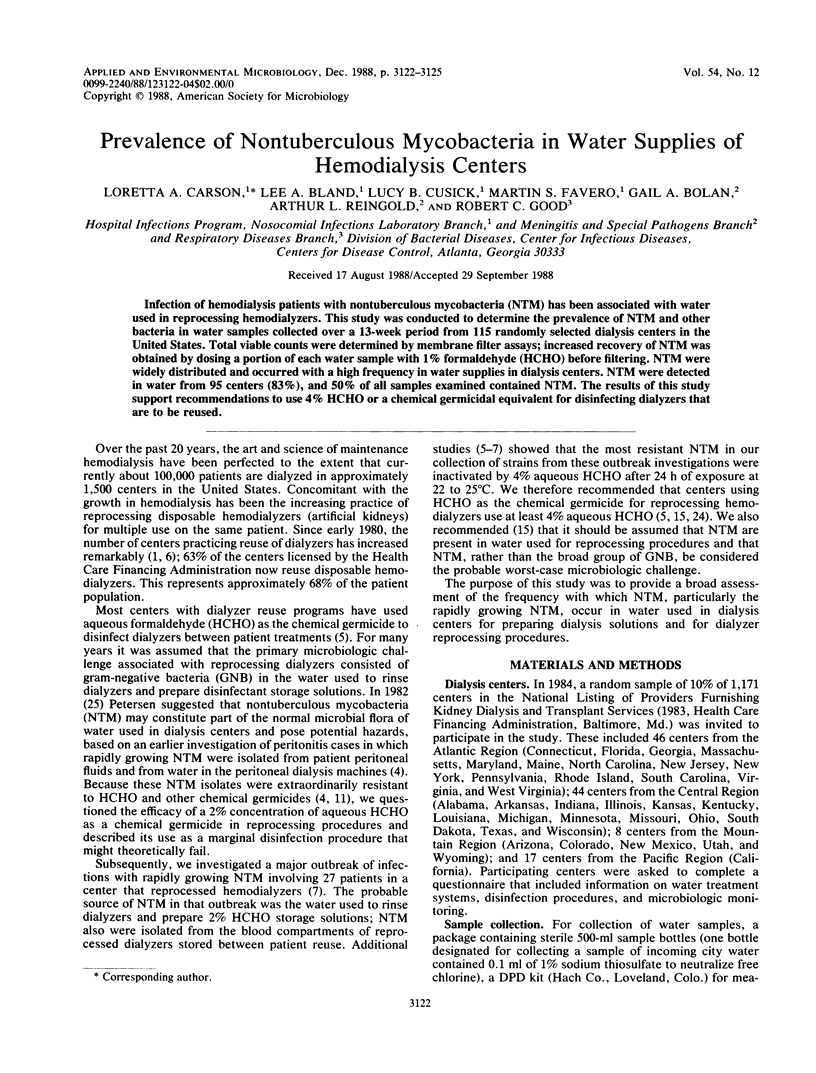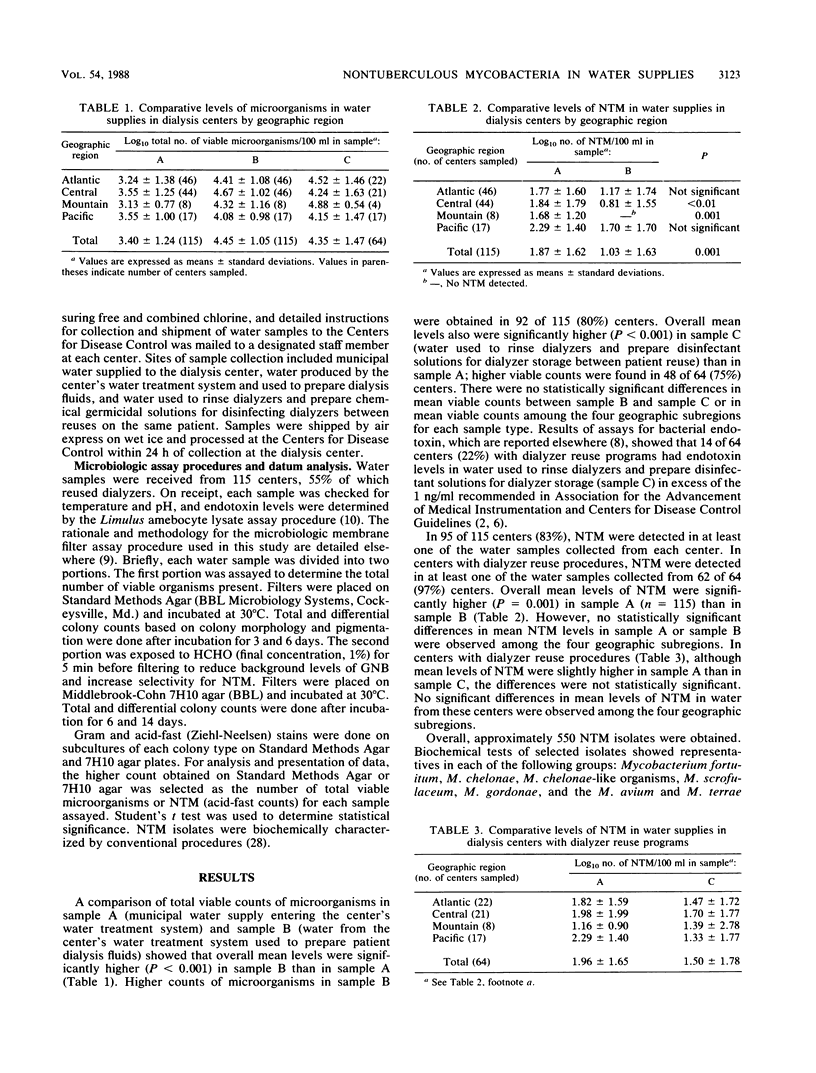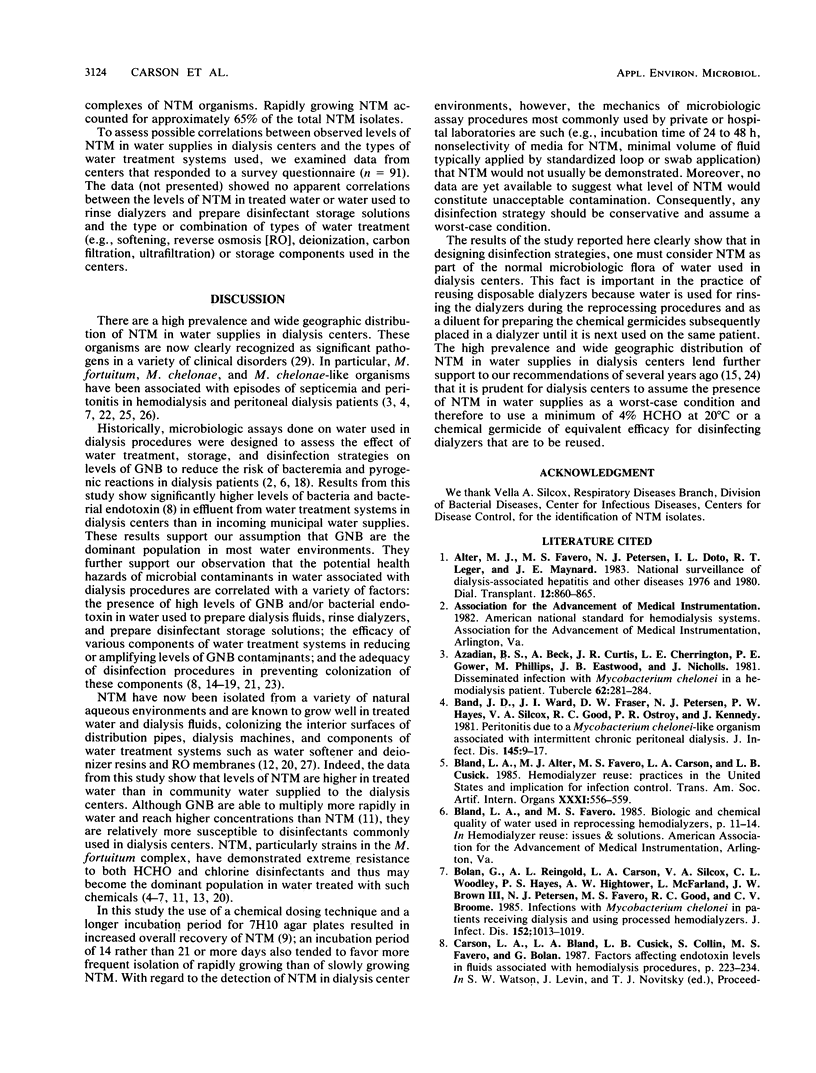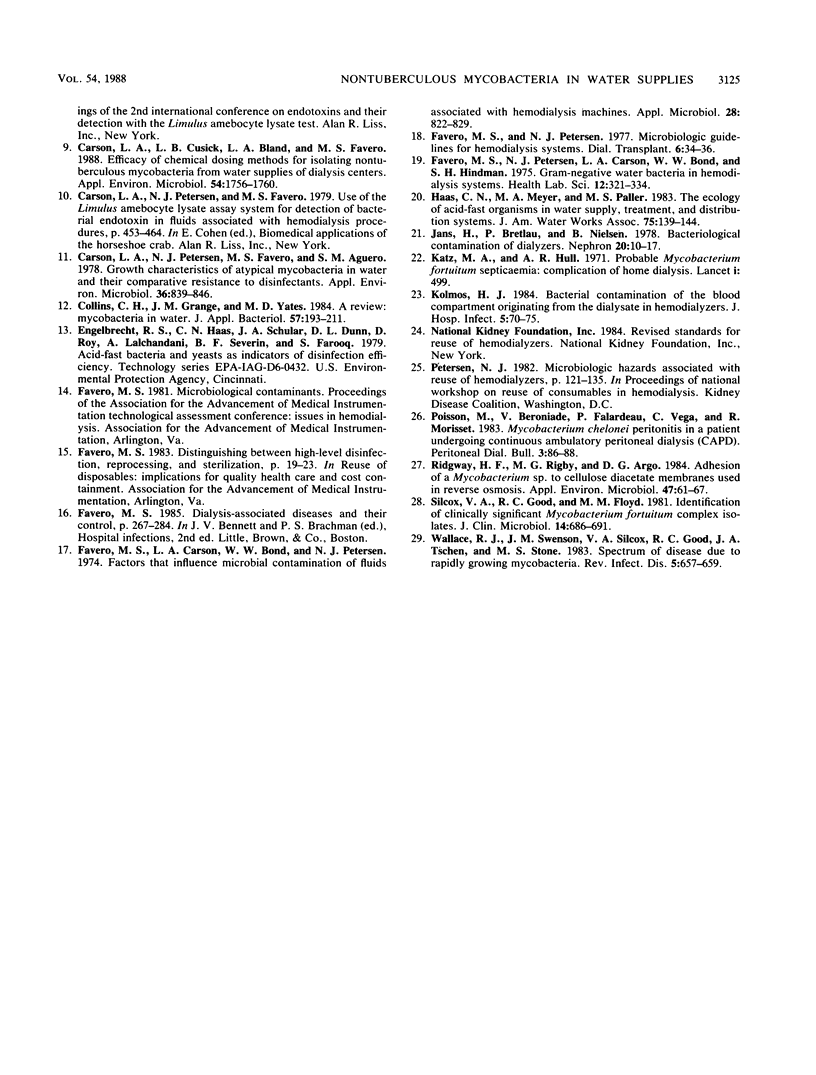Abstract
Infection of hemodialysis patients with nontuberculous mycobacteria (NTM) has been associated with water used in reprocessing hemodialyzers. This study was conducted to determine the prevalence of NTM and other bacteria in water samples collected over a 13-week period from 115 randomly selected dialysis centers in the United States. Total viable counts were determined by membrane filter assays; increased recovery of NTM was obtained by dosing a portion of each water sample with 1% formaldehyde (HCHO) before filtering. NTM were widely distributed and occurred with a high frequency in water supplies in dialysis centers. NTM were detected in water from 95 centers (83%), and 50% of all samples examined contained NTM. The results of this study support recommendations to use 4% HCHO or a chemical germicidal equivalent for disinfecting dialyzers that are to be reused.
Full text
PDF



Selected References
These references are in PubMed. This may not be the complete list of references from this article.
- Azadian B. S., Beck A., Curtis J. R., Cherrington L. E., Gower P. E., Phillips M., Eastwood J. B., Nicholls J. Disseminated infection with mycobacterium chelonei in a haemodialysis patient. Tubercle. 1981 Dec;62(4):281–284. doi: 10.1016/s0041-3879(81)80009-8. [DOI] [PubMed] [Google Scholar]
- Band J. D., Ward J. I., Fraser D. W., Peterson N. J., Silcox V. A., Good R. C., Ostroy P. R., Kennedy J. Peritonitis due to a mycobacterium chelonei-like organism associated with intermittent chronic peritoneal dialysis. J Infect Dis. 1982 Jan;145(1):9–17. doi: 10.1093/infdis/145.1.9. [DOI] [PubMed] [Google Scholar]
- Bland L., Alter M., Favero M., Carson L., Cusick L. Hemodialyzer reuse: practices in the United States and implication for infection control. Trans Am Soc Artif Intern Organs. 1985;31:556–559. [PubMed] [Google Scholar]
- Bolan G., Reingold A. L., Carson L. A., Silcox V. A., Woodley C. L., Hayes P. S., Hightower A. W., McFarland L., Brown J. W., 3rd, Petersen N. J. Infections with Mycobacterium chelonei in patients receiving dialysis and using processed hemodialyzers. J Infect Dis. 1985 Nov;152(5):1013–1019. doi: 10.1093/infdis/152.5.1013. [DOI] [PubMed] [Google Scholar]
- Carson L. A., Bland L. A., Cusick L. B., Collin S., Favero M. S., Bolan G. Factors affecting endotoxin levels in fluids associated with hemodialysis procedures. Prog Clin Biol Res. 1987;231:223–234. [PubMed] [Google Scholar]
- Carson L. A., Cusick L. B., Bland L. A., Favero M. S. Efficacy of chemical dosing methods for isolating nontuberculous mycobacteria from water supplies of dialysis centers. Appl Environ Microbiol. 1988 Jul;54(7):1756–1760. doi: 10.1128/aem.54.7.1756-1760.1988. [DOI] [PMC free article] [PubMed] [Google Scholar]
- Carson L. A., Petersen N. J., Favero M. S., Aguero S. M. Growth characteristics of atypical mycobacteria in water and their comparative resistance to disinfectants. Appl Environ Microbiol. 1978 Dec;36(6):839–846. doi: 10.1128/aem.36.6.839-846.1978. [DOI] [PMC free article] [PubMed] [Google Scholar]
- Carson L. A., Petersen N. J., Favero M. S. Use of the Limulus amoebocyte lysate assay system for detection of bacterial endotoxin in fluids associated with hemodialysis procedures. Prog Clin Biol Res. 1979;29:453–464. [PubMed] [Google Scholar]
- Collins C. H., Grange J. M., Yates M. D. Mycobacteria in water. J Appl Bacteriol. 1984 Oct;57(2):193–211. doi: 10.1111/j.1365-2672.1984.tb01384.x. [DOI] [PubMed] [Google Scholar]
- Favero M. S., Carson L. A., Bond W. W., Petersen N. J. Factors that influence microbial contamination of fluids associated with hemodialysis machines. Appl Microbiol. 1974 Nov;28(5):822–830. doi: 10.1128/am.28.5.822-830.1974. [DOI] [PMC free article] [PubMed] [Google Scholar]
- Favero M. S., Petersen N. J., Carson L. A., Bond W. W., Hindman S. H. Gram-negative water bacteria in hemodialysis systems. Health Lab Sci. 1975 Oct;12(4):321–334. [PubMed] [Google Scholar]
- Jans H., Bretlau P., Nielsen B. Bacteriological contamination of dialyzers. Clinical, bacteriological and scanning electron-microscopic evaluation of different dialysate mixing systems. Nephron. 1978;20(1):10–17. doi: 10.1159/000181190. [DOI] [PubMed] [Google Scholar]
- Katz M. A., Hull A. R. Probable Mycobacterium fortuitum septicemia: complication of home dialysis. Lancet. 1971 Mar 6;1(7697):499–499. doi: 10.1016/s0140-6736(71)91116-0. [DOI] [PubMed] [Google Scholar]
- Kolmos H. J. Bacterial contamination of the blood compartment originating from the dialysate in haemodialysers. J Hosp Infect. 1984 Mar;5(1):70–75. doi: 10.1016/0195-6701(84)90103-8. [DOI] [PubMed] [Google Scholar]
- Ridgway H. F., Rigby M. G., Argo D. G. Adhesion of a Mycobacterium sp. to cellulose diacetate membranes used in reverse osmosis. Appl Environ Microbiol. 1984 Jan;47(1):61–67. doi: 10.1128/aem.47.1.61-67.1984. [DOI] [PMC free article] [PubMed] [Google Scholar]
- Silcox V. A., Good R. C., Floyd M. M. Identification of clinically significant Mycobacterium fortuitum complex isolates. J Clin Microbiol. 1981 Dec;14(6):686–691. doi: 10.1128/jcm.14.6.686-691.1981. [DOI] [PMC free article] [PubMed] [Google Scholar]
- Wallace R. J., Jr, Swenson J. M., Silcox V. A., Good R. C., Tschen J. A., Stone M. S. Spectrum of disease due to rapidly growing mycobacteria. Rev Infect Dis. 1983 Jul-Aug;5(4):657–679. doi: 10.1093/clinids/5.4.657. [DOI] [PubMed] [Google Scholar]


